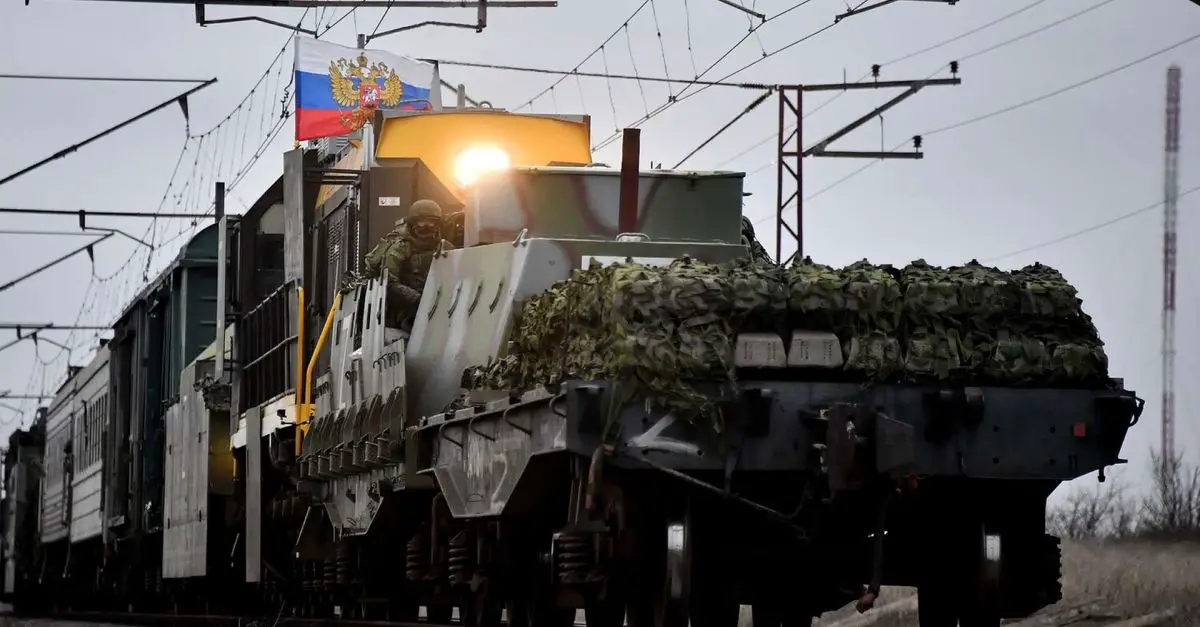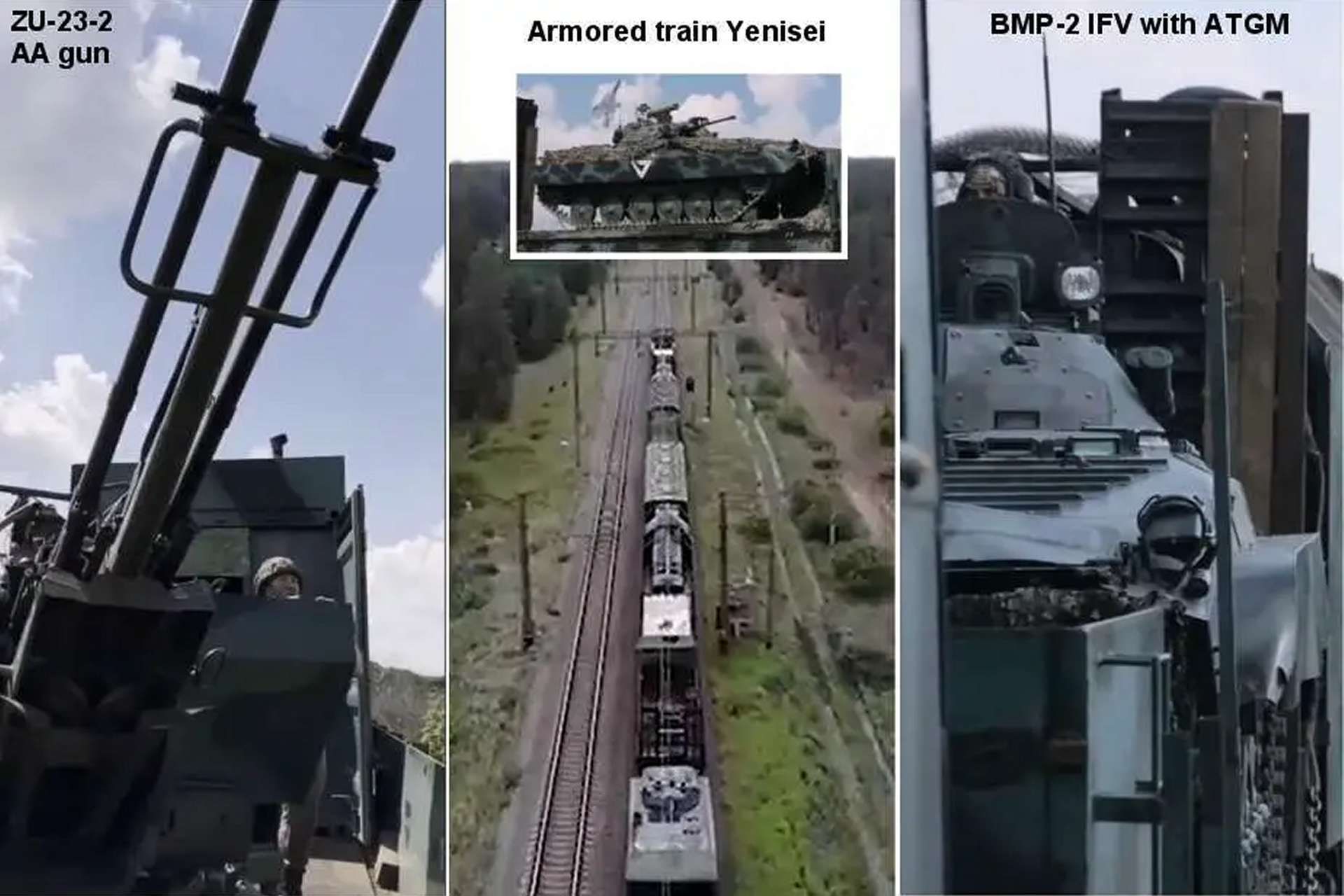Breaking news
Why does Russia still use outdated armored trains in Ukraine?.
As reported by Michael Stroud on May 1, 2024, despite their perceived obsolescence by many military forces worldwide, Russia continues to use armored trains for their combination of mobility, protection, and logistical capabilities. In Ukraine, as reported several times by the Army Recognition editorial team, these trains are used to secure extensive railway networks and support military operations in contested areas.
Follow Army Recognition on Google News at this link

By the end of the 20th century, many global military forces had phased out armored trains, deeming them outdated, but the First Chechen War prompted a reevaluation by the Russian Army of the potential value of such vehicles. (Picture source: Russian social media)
By the end of the 20th century, many global military forces had phased out armored trains, deeming them outdated. For instance, the last serial Soviet armored train, the BP-1, designed to protect railway lines near the Soviet-Chinese border, was retired in the early 1990s. The First Chechen War in 1994 prompted a reevaluation by the Russian Army of the potential value of such vehicles due to practical necessities such as supplying troops with essential materials in challenging terrains and countering sabotage risks by armed groups. The Federal Service of the Railway Troops, later succeeded by the Command of the Railway Troops of the Russian Federation, took on responsibilities like restoring railway infrastructure, securing military transports, and providing protection, leading to the reintroduction of specialized armored trains.
During the Second Chechen War, which started in 1999, armored trains proved strategically valuable in safeguarding railways. Specialized trains were used extensively during the campaign, although the deteriorated railway infrastructure in Chechnya led to their cessation of movement through the region by November 1994. By 2002, special trains like "Amur," "Baikal," and "Terek" were established. In 2005, Major General V. Leshchishin reported four special trains within the United Group of Forces (OGV), including the "Don," which focused on tasks such as construction, escorting trains through hazardous sections, conducting engineering reconnaissance, demining, and addressing sabotage aftermath. Despite attacks, their operational effectiveness led to their retention within the Russian military.
Therefore, it is unsurprising that Russia still uses armored trains in Ukraine, as these vehicles are ideal for the extensive railway networks present in the country, spanning from the Luhansk region to Crimea. So far, Russia has been confirmed to have employed three armored trains in Ukraine: the Baikal and Amur, as well as the previously undisclosed Yenisei. These armored trains offer a unique combination of mobility, protection, and versatility that is difficult to replicate with other military assets.
These trains can transport troops, equipment, and supplies through contested areas while providing a fortified platform for command and control operations. They are equipped with various weapon systems, including anti-aircraft guns and artillery, which allow them to support ground operations and defend against aerial and ground threats. Their armored nature provides a high level of protection against small arms fire and shrapnel, making them resilient in hostile environments.
Moreover, the use of armored trains leverages existing rail infrastructure, which is extensive in Ukraine and the surrounding regions. Railways can facilitate the rapid movement of large quantities of military supplies and personnel across vast distances, essential for sustaining prolonged operations. This logistical advantage is significant in the context of Russia's military strategy, which often involves securing and holding large territories. Thus, while they may seem anachronistic, armored trains remain a practical asset in Russia's military toolkit.

Additional platforms, such as those observed on the Yenisei, are outfitted with 23mm ZU-23-2 anti-aircraft autocannons or BMP-2 infantry fighting vehicles, providing both defensive and offensive capabilities against diverse threats. (Picture source: Russian social media)
In Ukraine, Russian "Amur", "Baikal", and "Yenisei" armored trains perform various roles, focusing on technical reconnaissance, railway demining, and the restoration of railway tracks and minor structures. They also escort both logistical and passenger trains and may assist in the evacuation of civilians from front-line areas.
Typically, a Russian armored train includes several platforms, with the first, the "cover platform," advancing ahead to detect and address landmines, ensuring safe passage. Crew members inspect the railway tracks and surrounding area for explosive devices, with specialized sappers deciding on disarming or detonating them. Reconnaissance efforts are supported by drone technology, which surveys the route ahead to identify obstacles. Maintenance and repair teams are crucial, with a designated wagon, the "Kapterka," carrying essential supplies for repairs and operational continuity. Locomotives at both ends of the train can execute controlled detonations if explosives are encountered.
Effective coordination and communication are facilitated by a mobile radio station mounted on a ZIL-131 6x6 truck, ensuring interaction among crew members and other units. Observers at each end of the train guide locomotive operators for precise movements. The primary mission is to protect railway tracks, infrastructure, and repair teams from sabotage, including track protection and preventing attacks on railway assets.
For safety, the central locomotive is reinforced with 20-millimeter steel walls and sandbags behind wooden panels. Platforms loaded with ballast materials like sandbags, rails, and sleepers provide additional protection against mine explosions. A jamming platform with the Kamysh system disrupts radio-controlled explosive devices within a 20-meter radius.
The personnel of a typical Russian armored train have access to a range of weapons, including 23mm anti-aircraft guns, automatic grenade launchers, assault rifles, and heavy machine guns. These armaments allow the train to engage both aerial and ground-based targets. Additionally, the train comprises several platforms, each armed to address various threats. Central to its structure is an armored box made of durable steel sheets, serving as a command center and housing weaponry, with firing openings on the sides for engaging targets from within. Two rotating turrets mounted on this armored box are armed with AGS-17 automatic grenade launchers and large-caliber machine guns, providing a 160-degree firing arc.
Additional platforms are equipped with 23mm ZU-23-2 anti-aircraft autocannons capable of a rapid fire rate of 2,000 rounds per minute, engaging both aerial and ground threats. Some platforms carry BMP-2 infantry fighting vehicles or potentially T-62 tanks, offering mobile firepower with their stabilized 30mm cannons, coaxial machine guns, smoke grenade dischargers, and anti-tank guided missile launchers, ensuring a range of defensive and offensive capabilities against various threats.


























